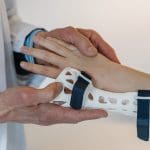
You Need a Friend: The Increasing Isolation of Community Orthopedic Practice
Dr. Theodore Schlegel, MD, Chief Medical Officer, American Orthopedic Partners
Dr. Thomas A. Dwyer, MD, FAAOS, President/CEO of Premier Orthopaedic Associates
Our topic reminds us of an old Chinese curse: may you live in interesting times. While nostalgia for the good old days isn’t helpful, the operational and strategic complexities added to the practice of orthopedics every year make us long for simpler times, when we could focus more on our patients and less on our business. A time when groups weren’t so competitive with one another, when there was more collaboration. A time when we weren’t so isolated from our peers; a time when we felt a stronger sense of community. Those days are gone.
Current Challenges. Running a community practice is really tough. Leaders need stamina, patience, wisdom, and foresight to tackle new requirements and complexities plus find the time to plan for growth and acquire capital; recruit new physicians and clinical staff; expand geographically; add new service lines, equipment, and technology; improve patient service and satisfaction; maintain excellence in clinical operations; and prepare for value-based care. That’s daunting for a practice on its own.
Community-based orthopedic surgery practices are not unique in having to face a constantly changing, ever more difficult environment. The obstacles we face are exacerbated by healthcare’s rapid consolidation, underway for both providers and insurers. Compared to other industries (eg. grocery stores and pharmacies), we’re late and overdue.
The pressure on providers has intensified by the out-of-balance leverage that the largest insurers now have, as well as ever more costly and difficult CMS requirements, like MACRA[1] and the 2023 CMS payment reductions of 4.48 percent[2]. And don’t forget CMS’ 2030 goal of having 100 percent of traditional Medicare beneficiaries in an accountable care relationship with their healthcare provider, thereby eliminating CMS fee-for-service reimbursements[3].
Only the strongest can survive this barrage of challenges.
Evolution. In addition to industry consolidation, current trends are:
- Continued movement from inpatient to outpatient settings for orthopedic surgery, including most joint replacements. Just in time for the Baby Boomers, whose need for new hips and knees is projected to grow respectively by 71 percent to 635,000 procedures and by 85 percent to 1.26 million procedures in 2030[4].
- Vertical integration: hospitals are acquiring orthopedic practices to maintain inpatient surgery volumes[5]; payors are acquiring or establishing strategic relationships with groups to guarantee an adequate supply for their members and align incentives for risk sharing
- An increasing reliance on technology: the integration of robots into both hospital and ambulatory surgery centers; robotics and sensor-assisted surgery; remote patient monitoring with wearable sensors; and the adoption of telehealth
- The shift continues toward value-based care and population health: broader data collection requirements, especially patient outcomes data; preparation to accept financial risk; preparation to manage a broad continuum of orthopedic care
- Direct contracts with self-funded employers featuring bundled payments for common orthopedic procedures
Innovations. Our profession continues to improve through innovation and the adoption of new technologies. Here is a partial list of the current capabilities we’re evaluating:
- Using AI and data analytics to improve the patient journey throughout care
- Orthobiologics and regenerative medicine: exploring the clinical application of new biologic techniques for difficult orthopedic conditions
- 3-D matrix printing for complex orthopedic implants and to replace deficient tissue
- Using remote monitoring technology to rethink and redesign orthopedic treatment paradigms
Bottom Line. Can you keep up? Success can be elusive for isolated practices. Many decide that they don’t want to be alone. There are a variety of available choices: aligning with or being acquired by a larger practice, being acquired or employed by a hospital, establishing a strategic relationship with a payor, becoming part of a multi-specialty group, and similar. We hope you find the right one.
Our bias kicks in here; the authors are physician leaders and shareholders of American Orthopedic Partners. We are extraordinarily happy and enthusiastic about the choice we made. If you would like to talk about your situation, please initiate contact:
[1] MACRA is the Medicare Access and CHIP Reauthorization Act of 2015. MACRA created a new framework for rewarding or punishing physicians (up to 9 percent) based on their participation in a Merit-based Incentive Payment System (MIPS) or Advanced Alternative Payment Models (AAPMs). Medicare fees for physicians who ignore MACRA are reduced by 9 percent.
[2] The CY 2023 PFS conversion factor is $33.06, a decrease of $1.55 from the CY 2022 conversion factor of $34.61; a decline of 4.48 percent.
[4] Sloan M, Premkumar A, Sheth NP. Projected Volume of Primary Total Joint Arthroplasty in the U.S., 2014 to 2030. J Bone Joint Surg Am. 2018 Sep 5;100(17):1455-1460. doi: 10.2106/JBJS.17.01617. PMID: 30180053.
[5] Orthopedic and cardiothoracic surgeries are normally the most profitable services for hospitals
References
- The future of orthopedic care delivery from 3 surgeons; Beckersspine, March 15, 2021
- Shaping Surgical Innovation and the Future of Orthopaedics; Yale School of Medicine; March 11, 2021
https://medicine.yale.edu/news-article/shaping-surgical-innovation-and-the-future-of-orthopaedics/
- The Future of Orthopaedic Surgery – Sparing the Scalpel?; Brian J. Cole, MD; April 21, 2022
https://www.youtube.com/watch?v=uPD66JYQRlo
- Digital Orthopedics: The Future Developments of Orthopedic Surgery, Zhonghai Li; Pers. Med.2023, 13(2), 292
https://doi.org/10.3390/jpm13020292
- Need a New Knee or Hip? A Robot May Help Install It
https://www.nytimes.com/2021/01/15/health/joint-replacement-baby-boomers-technology.html













Sorry, the comment form is closed at this time.